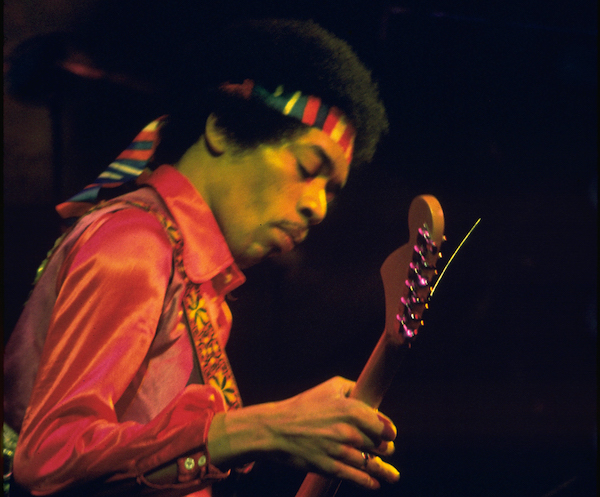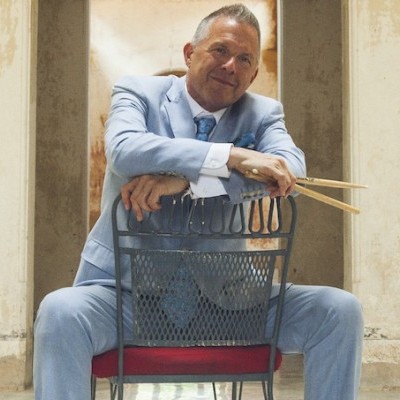Oct 28, 2025 10:47 AM
In Memoriam: Jack DeJohnette, 1942–2025
Jack DeJohnette, a bold and resourceful drummer and NEA Jazz Master who forged a unique vocabulary on the kit over his…

Jimi Hendrix’s performances on Dec. 31, 1969, and Jan. 1, 1970, at the Fillmore East in New York rank as a unique moment in the guitarist’s career.
(Photo: Allan Herr/MoPOP/Authentic Hendrix, LLC)All of Hendrix’s royalties due from Warner-Reprise were ordered placed into escrow by the court pending a settlement. That settlement involved the release of Band Of Gypsys, which Chalpin (who could not be reached for comment) then licensed to Warner Bros. rival Capitol Records—in effect, a live album banged out fast and cheap in order to appease the claimant.
“Jimi was an itinerant sideman who did a lot of session work in the mid-’60s before he achieved his fame,” McDermott explained. “In this particular instance, he was recording at PPX on some Curtis Knight records and signed what he [apparently] thought was a work-for-hire release. He looked at it as something you sign to just get paid, but he ended up signing a three-year agreement for anything that he did.
“And, of course, to Ed Chalpin, these contracts were like lottery tickets,” McDermott continued. “I think Chalpin did this to folks so that if they ever hit [it big], he had a hold of them. And, of course, come fall of ’66 with the release of ‘Hey Joe’ in England, and then certainly by the early part of ’67, once ‘Purple Haze’ and ‘The Wind Cries Mary’ hit, Chalpin took notice of what was happening in England. That’s when he kind of stepped up and said, ‘I have a claim.’
“Warner Bros. pushed for a settlement because Hendrix was so hot at the time, so they just said, ‘Look, let’s just get rid of this guy. Give Capitol a record and let’s be done with it. It’s not a big deal.’ And Jimi went along with it, as did his manager.”
By the fall of ’69, Hendrix’s relationship with Jeffery, his manager, was damaged beyond repair; Warner Bros. was pressing him for new product in the wake of the Experience dissolving; and he was facing the prospect of a lawsuit with PPX. Additionally, he was hampered with a massive creative block, driven in part by stress, drug abuse and sheer exhaustion. Amid the mounting pressure, Hendrix was facing a drug trial in Toronto on Dec. 8, after a May 3, 1969, bust, when he was detained and charged with illegal possession of narcotics. (A jury would acquit him of all charges on Dec. 10.)
“He was struggling to kind of confirm his next direction,” McDermott said. “In the end, with the pressure on, he just finally said, ‘OK, we’re going to come together and we’ll do this thing at the Fillmore East and make a live record.’”
The result was a throbbing display of earthy blues- and r&b-rooted rock—the work of three kindred spirits. “Billy and Buddy had a lot of common ground with Jimi,” McDermott said. “As a session man, Billy had played on recordings by Gatemouth Brown and Slim Harpo, and he and Jimi had played on the Chitlin’ Circuit together. ... And like Jimi, Buddy had been on the road with Wilson Pickett and he also played with the Ink Spots, Ruby & The Romantics and the Delfonics. So, r&b was part of his roots, also.”
Cox recently explained the band’s camaraderie: “I sensed there was something very special about the marriage of Jimi, Buddy and myself. We jelled right from the get-go. We were all friends, we were about the same age, we had come up under the same type of music and shared a deep love of the blues. So, Jimi didn’t really have to verbalize much at all during the rehearsals. He’d come up with a riff and we just played up against what he did, and we made it all work.
“We were like brothers and we shared that same feeling. Jimi used to say, ‘We’re just musicians, we’re just a band of gypsies. We go from city to city, town to town, doing our thing, and we’re completely free.’ And that’s why the band worked so well, because there was no pressure. Creative musicians work very well when they are not under pressure.”
McDermott suggested that Hendrix’s handpicked rhythm team was a key to the success of the Band of Gypsys project. “When Noel Redding left the Experience, Jimi could’ve had any bass player in the world, but he went back to a guy he knew, who was a solid player and a great friend in Billy Cox. I think he knew what he needed in his life at that time, which was some certainty, a solid guy he could trust, who understood the journey he had been on to get there. Billy represented that. And Buddy was just a vivacious, funny guy who attacked the drums with such a passion that Jimi loved him for it. And Buddy’s feel was so different from what Mitch had given Jimi that it had to be exciting for him to be dealing with this totally different flavor that allowed him to take it out as far as he wanted to.”
Hendrix had plenty of previous experience with Miles, who had played drums on “Rainy Day, Dream Away” and “Still Raining, Still Dreaming” on 1968’s Electric Ladyland. And the guitarist co-produced and played on Miles’ 1969 album, Electric Church.
The bandleader started demoing ideas on Nov. 7 with Cox and Miles at the Record Plant in New York, then intensified rehearsals at Baggy Studios on Dec. 15, 18 and 19. It was there that Band of Gypsys quickly developed a repertoire in preparation for their upcoming Fillmore East concerts on Dec. 31 and Jan. 1. The aesthetic explored at these rehearsals brought out something different in Jimi’s playing. Whereas Mitchell emulated Elvin Jones’ jazzy triplet feel and flowing-over-the-barline elasticity, Miles’ strength was maintaining a steady, imposing backbeat. Together with Cox’s solid, uncluttered bass lines, they grooved in a powerful, undeniably funky way on slamming vehicles like “Power Of Soul,” “Who Knows” and “Message To Love,” as well as the Miles compositions “Them Changes” and “We Gotta Live Together.” The band reaches a mesmerizing peak with the transcendent “Machine Gun,” accented by Miles’ snare shots.

Jack DeJohnette boasted a musical resume that was as long as it was fearsome.
Oct 28, 2025 10:47 AM
Jack DeJohnette, a bold and resourceful drummer and NEA Jazz Master who forged a unique vocabulary on the kit over his…

Always a sharp dresser, Farnsworth wears a pocket square given to him by trumpeter Art Farmer. “You need to look good if you want to hang around me,” Farmer told him.
Sep 23, 2025 11:12 AM
When he was 12 years old, the hard-swinging veteran drummer Joe Farnsworth had a fateful encounter with his idol Max…

D’Angelo achieved commercial and critical success experimenting with a fusion of jazz, funk, soul, R&B and hip-hop.
Oct 14, 2025 1:47 PM
D’Angelo, a Grammy-winning R&B and neo-soul singer, guitarist and pianist who exerted a profound influence on 21st…

Kandace Springs channeled Shirley Horn’s deliberate phrasing and sublime self-accompaniment during her set at this year’s Pittsburgh International Jazz Festival.
Sep 30, 2025 12:28 PM
Janis Burley, the Pittsburgh International Jazz Festival’s founder and artistic director, did not, as might be…

Jim McNeely’s singular body of work had a profound and lasting influence on many of today’s top jazz composers in the U.S. and in Europe.
Oct 7, 2025 3:40 PM
Pianist Jim McNeely, one of the most distinguished large ensemble jazz composers of his generation, died Sept. 26 at…